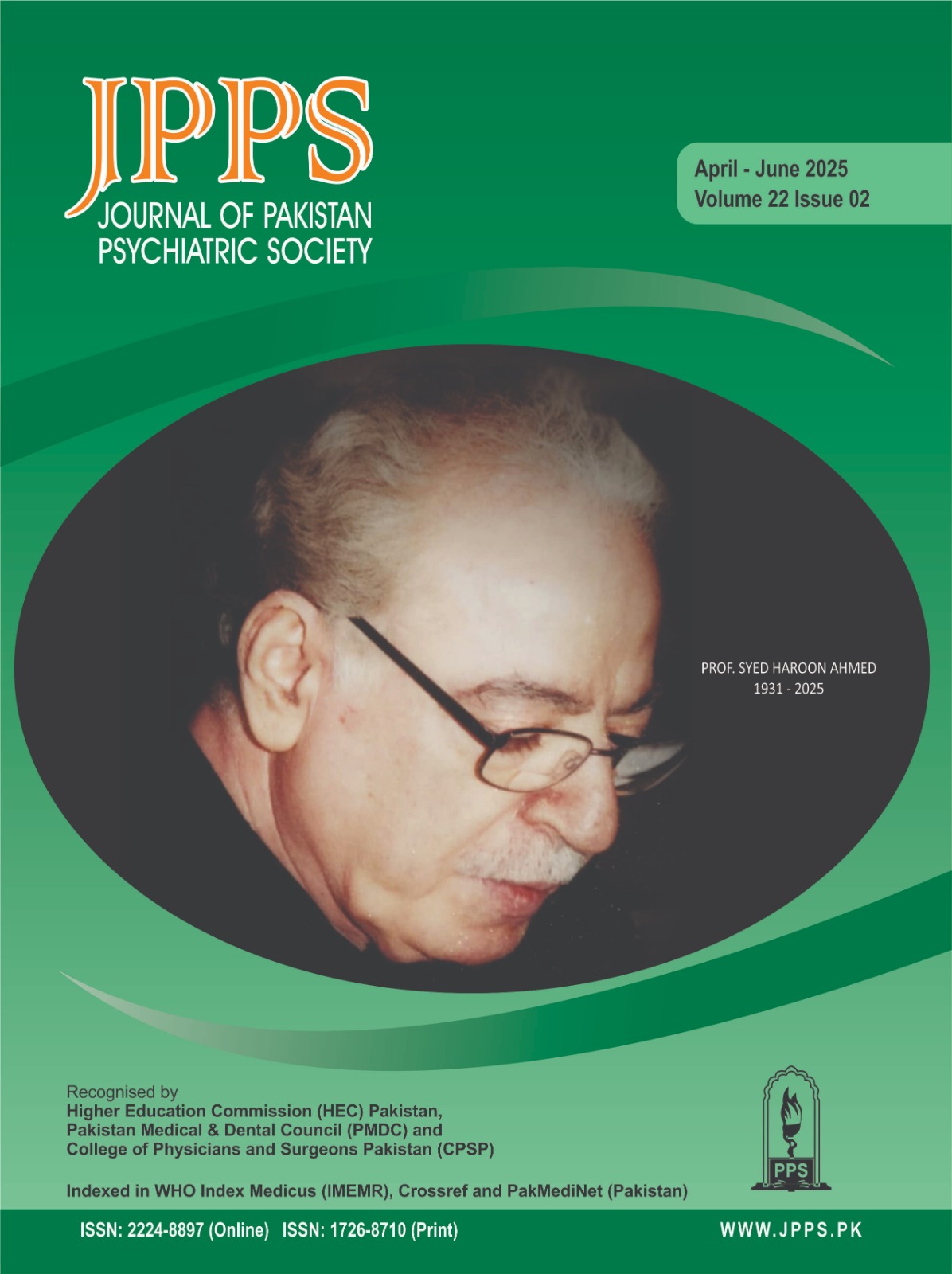Narcissistic Tendencies, Psychological Need Satisfaction, And Selfie-Taking Behavior in Youth
Abstract
Objective: To explore the relationship between narcissistic tendencies, psychological need satisfaction and selfie-taking behaviour in youth.
Study Design: Research design of the study was correlational cross-sectional.
Place and Duration of Study: The study was conducted between March 2023 to February 2024 in the Department of Applied Psychology, University of Management and Technology Lahore.
Subjects and Methods: The sample comprised of 200 youth with age range of 18 to 30 years (M= 21.99, SD=2.25) including 79 men and 121 women. The data was collected from eight different universities of Lahore by employing convenience sampling technique. A self-constructed demographic information sheet, Narcissistic tendencies Inventory Scale (NPI-16), Basic Need Satisfaction in General Scale and Selfitis Behaviour Scale were used for the assessments.
Results: The result indicated the positive relationship between narcissistic tendencies and selfie-taking behavior and negative relationship was found between psychological need satisfaction and selfie-taking behavior. Furthermore, no relationship was found between narcissistic tendencies and psychological need satisfaction. The result showed that narcissistic tendencies positively predicted the selfie-taking behavior, however psychological need satisfaction did not predict it. The results also showed men scored higher on narcissism and selfie-taking behavior.
Conclusion: The present study helped us know how selfie-taking behaviors are related to narcissistic tendencies in young educated sample.
Downloads
References
2. Balakrishnan J, Griffiths MD. An exploratory study of “Selfitis” and the development of the selfitis Behavior scale. International Journal of Mental Health and Addiction. 2017 Nov 29;16(3):722–36. https://doi.org/10.1007/s11469-017-9844-x
3. Barry CT, Doucette H, Loflin DC, Rivera-Hudson N, Herrington LL. “Let me take a selfie”: Associations between self-photography, narcissism, and self-esteem. Psychology of popular media culture. 2017 Jan;6(1):48. https://doi.org/10.1037/ppm0000089
4. Weiser EB. Me: Narcissism and its facets as predictors of selfie-posting frequency. Personality and individual differences. 2015 Nov 1;86:477-81. https://doi.org/10.1016/j.paid.2015.07.007
5. Pawar K, Verma N, Somaiya M, Kedare J, Mehta F, Tyagi A, et al. Selfie-taking behavior: Personality factors, self-esteem, and interpersonal closeness in college-going students in a Metropolitan City. Indian Journal of Social Psychiatry (Online)/Indian Journal of Social Psychiatry. 2020 Jan 1;36(3):230. https://doi.org/10.4103/ijsp.ijsp_31_19
6. Carpenter CJ. Narcissism on Facebook: Self-promotional and anti-social behavior. Personality and individual differences. 2012 Mar 1;52(4):482-6. https://doi.org/10.1016/j.paid.2011.11.011
7. Morf CC, Torchetti L, Schürch E. Narcissism from the perspective of the dynamic self‐regulatory processing model. The handbook of narcissism and narcissistic personality disorder: Theoretical approaches, empirical findings, and treatments. 2011 Jul 20:56-70. https://doi.org/10.1002/9781118093108.ch6
8. Zeigler-Hill V, Dehaghi AMB. Narcissism and psychological needs for social status, power, and belonging. Personality and Individual Differences. 2023 Aug 1;210:112231. https://doi.org/10.1016/j.paid.2023.112231
9. Mahadevan N, Jordan C. Desperately seeking status: How desires for, and perceived attainment of, status and inclusion relate to grandiose and vulnerable narcissism. Personality and Social Psychology Bulletin. 2022 May;48(5):704-17. https://doi.org/10.1177/01461672211021189
10. Krizan Z, Johar O. Narcissistic rage revisited. Journal of Personality and Social Psychology. 2015 May 1;108(5):784–801. https://doi.org/10.1037/pspp0000013
11. Morf CC, Rhodewalt F. Narcissism and Self-Evaluation Maintenance: Explorations in Object Relations. Personality & Social Psychology Bulletin. 1993 Dec 1;19(6):668–76. https://doi.org/10.1177/0146167293196001
12. Diefenbach S, Christoforakos L. The selfie paradox: Nobody seems to like them yet everyone has reasons to take them. An exploration of psychological functions of selfies in Self-Presentation. Frontiers in Psychology . 2017 Jan 17;08. https://doi.org/10.3389/fpsyg.2017.00007
13. Carpenter CJ. Narcissism on Facebook: Self-promotional and anti-social behavior. Personality and Individual Differences. 2012 Mar 1;52(4):482–6. https://doi.org/10.1016/j.paid.2011.11.011
14. Tandoc EC, Lou C, Min VLH. Platform-swinging in a poly-social-media context: How and why users navigate multiple social media platforms. Journal of Computer-mediated Communication. 2018 Oct 29;24(1):21–35. https://doi.org/10.1093/jcmc/zmy022
15. Wang R, Yang F, Haigh MM. Let me take a selfie: Exploring the psychological effects of posting and viewing selfies and groupies on social media. Telematics and Informatics. 2017 Jul 1;34(4):274–83. https://doi.org/10.1016/j.tele.2016.07.004
16. Deci EL, Ryan RM. The “What” and “Why” of goal pursuits: human needs and the Self-Determination of behavior. Psychological Inquiry. 2000 Oct 1;11(4):227–68. https://doi.org/10.1207/S15327965PLI1104_01
17. Liu Y, Liu RD, Ding Y, Wang J, Zhen R, Xu L. How online basic psychological need satisfaction influences self-disclosure online among Chinese adolescents: Moderated mediation effect of exhibitionism and narcissism. Frontiers in Psychology. 2016 Aug 26;7:1279. https://doi.org/10.3389/fpsyg.2016.01279
18. Ames DR, Rose P, Anderson CP. The NPI-16 as a short measure of narcissism. Journal of Research in Personality. 2006 Aug 1;40(4):440–50. https://doi.org/10.1016/j.jrp.2005.03.002
19. La Guardia JG, Ryan RM, Couchman CE, Deci EL. Within-person variation in security of attachment: a self-determination theory perspective on attachment, need fulfillment, and well-being. Journal of personality and social psychology. 2000 Sep;79(3):367.
20. Balakrishnan J, Griffiths MD. An exploratory study of “selfitis” and the development of the Selfitis Behavior Scale. International journal of mental health and addiction. 2018 Jun;16(3):722-36. https://doi.org/10.1007/s11469-017-9844-x
21. Sorokowski P, Sorokowska A, Oleszkiewicz A, Frackowiak T, Huk A, Pisanski K. Selfie posting behaviors are associated with narcissism among men. Personality and Individual Differences. 2015 Oct 1;85:123–7. https://doi.org/10.1016/j.paid.2015.05.004
22. Bhachech JT. Selfie and narcissism in young adults. Jurnal Tazkiya/Tazkiya Journal of Psychology/Tazkiya. 2021 Oct 30;9(2):153–63. https://doi.org/10.15408/tazkiya.v9i2.21558
23. Arpaci I, Tak P, Shekhawat H. The moderating role of exhibitionism in the relationship between psychological needs and selfie-posting behavior. Current Psychology. 2021 Apr 13;42(5):3610–6. https://doi.org/10.1007/s12144-021-01732-5
24. Puthiyakath HH, R NA, Angel S, Goswami MP. Selfie Syndrome: A study of selfitis and Narcissism among young adults. Journal of Creative Communications/Journal of Creative Communications. 2024 Feb 18; https://doi.org/10.1177/09732586231223603
25. Lal R, Singh J. Selfitis Behavior, Narcissism and Body Image among Youth : A study. ResearchGate. 2022 Nov 9; https://www.researchgate.net/publication/373688759_Selfitis_Behavior_Narcissism_and_Body_Image_Among_Youth_A_Study
26. Malik NI, Zafar J, Saleemi A. Narcissism and self-esteem as predictors of selfitis among youth. Rawal Medical Journal. 2020 May 9;45(2):331-3. https://www.researchgate.net/profile/Najma-Malik/publication/341271607_Narcissism_and_Self-esteem_as_predictors_of_Selfitis/links/5eb6e12f92851cd50da3bce7/Narcissism-and-Self-esteem-as-predictors-of-Selfitis.pdf
27. Barry CT, Loflin DC, Doucette H. Adolescent self-compassion: Associations with narcissism, self-esteem, aggression, and internalizing symptoms in at-risk males. Personality and Individual Differences. 2015 Apr 1;77:118–23. https://doi.org/10.1016/j.paid.2014.12.036
28. Shane-Simpson C, Schwartz AM, Abi-Habib R, Tohme P, Obeid R. I love my selfie! An investigation of overt and covert narcissism to understand selfie-posting behaviors within three geographic communities. Computers in Human Behavior. 2020 Mar 1;104:106158. https://doi.org/10.1016/j.chb.2019.106158
29. Giordano C, Salerno L, Pavia L, Cavani P, Lo Coco G, Tosto C, et al. Magic Mirror on the Wall: Selfie-Related behavior as mediator of the relationship between narcissism and problematic smartphone use. PubMed. 2019 Oct 1;16(5–6):197–205. https://doi.org/10.36131/clinicalnpsych2019050602
30. Kura S, Maheshwari S K Dr, Presha Dr. Narcissistic Personality and Selfie Taking Behavior among College Students. International Journal of medical and health research. 2018 May 3;56-60. https://www.researchgate.net/publication/326032982_Narcissistic_Personality_and_Selfie_Taking_Behavior_among_College_Students
31. Dutta E, Sharma P, Dikshit R, Shah N, Sonavane S, Bharati A, et al. Attitudes toward selfie taking in school-going adolescents: an exploratory study. Indian Journal of Psychological Medicine. 2016 May 1;38(3):242–5. https://doi.org/10.4103/0253-7176.183094
32. Asgher S Dr, Gohar I, Latif F Dr. Binge watching on internet television networks: Effects on youth. Pakistan Languages and Humanities Review. 2022 Dec 30;6(IV). https://doi.org/10.47205/plhr.2022(6-IV)13
33. Aguilo V, Gerente A, Marasigan P. Selfie-taking behavior and narcissistic tendencies of college students. International Review of Social Sciences Research/International Review of Social Sciences Research. 2022 May 22;2(2):1–20. https://doi.org/10.53378/352887
34. Moon JH, Lee E, Lee JA, Choi TR, Sung Y. The role of narcissism in self-promotion on Instagram. Personality and Individual Differences . 2016 Oct 1;101:22–5. https://doi.org/10.1016/j.paid.2016.05.042
Copyright (c) 2025 Journal of Pakistan Psychiatric Society

This work is licensed under a Creative Commons Attribution-NonCommercial 4.0 International License.
Copyright © JPPS. Published by Pakistan Psychiatric Society
Licensing: This work is licensed under Creative Commons Attribution-NonCommercial 4.0 International License
Readers may “Share-copy and redistribute the material in any medium or format” and “Adapt-remix, transform, and build upon the material”. The readers must give appropriate credit to the source of the material and indicate if changes were made to the material. Readers may not use the material for commercial purposes. The readers may not apply legal terms or technological measures that legally restrict others from doing anything the license permits.






.png)









